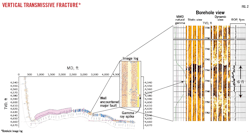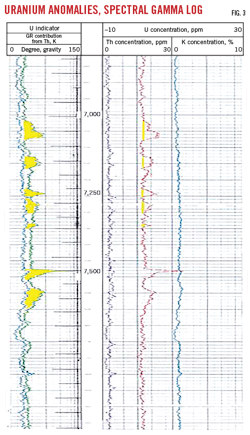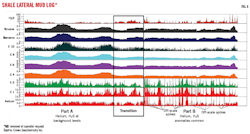Permian operators apply ROZ science to shales
L. Stephen Melzer
Melzer Consulting
Midland, Tex.
David B. Vance
Arcadis US Inc.
Midland, Tex.
Permian basin operators are combining diagnostic measurements with the science of residual oil zones (ROZ) to understand how one horizontal well in a shale produces sweet oil while an adjacent lateral at the same depth with the same completion produces sour oil.
ROZ science enables operators to avoid drilling into a transmissive fracture and avoid low oil-cut laterals.
A behind-the-scenes ROZ play has quietly evolved in the last 5 years involving producing unconventional (residual) oil from conventional reservoirs as contrasted to producing conventional oil from unconventional (shale) reservoirs.
ROZ production exploits residual oil from carbonate shelves by depressuring (dewatering) the reservoir and allowing entrained gas to expand, forcing out the oil. These wells often produce water for weeks before oil begins to move. Fig. 1 shows the ROZ production process.
Peak ROZ production potential is less than a shale well, but the decline curves are more gradual.
San Andres ROZ
The San Andres formation in the Permian basin offers scientific study and exploration results from a reservoir depth of 4,000-5,500 ft. It also provides a new horizontal well data base, including 600 laterals ranging 1- to 1.5-mile long and producing 50,000 b/d.
All the wells drilled are within mapped San Andres ROZ fairways where numerous drilled vertical wells proved uncommercial. Some main pay zones (MPZs) present in the ROZ fairways are structural closures of isolated mobile oil zones atop the laterally swept ROZs.
Companies have studied ROZs beneath San Andres oil fields since the 1990s to quantify oil saturation and determine if carbon dioxide (CO2) flooding could work as well in ROZs as it has in the water-flooded MPZs.
Industry depressures and water flooded MPZs, followed by CO2 flooding. In the ROZs, nature water flooded the ROZs, prompting industry to try CO2. Data show that the naturally laterally swept zones leave 30-45% of oil behind in the oil-wetted San Andres formation. Where lateral sweep was not extensive, remaining solution gas can help develop a successful EOR project and often provide the drive needed for reservoir depressuring.
Industry successfully extended 18 different MPZ CO2 floods below the producing oil-water contacts into the San Andres ROZs. Operators drilled 600 horizontal wells for reservoir depressuring. CO2 flooding and reservoir depressuring are the two ways to exploit oil in the ROZ.
The Research Partnership to Secure Energy for America (RPSEA) financed two studies1 in which researchers have characterized many of the ROZs to be 300-400 ft thick, numerically modeled natural water flood sweeps, and mapped ROZ fairways.
Meanwhile, newly acquired reservoir data coming from horizontal laterals provides industry with new understanding about some active processes in slow-flow fields in the ROZ reservoirs compared with static, mobile oil MPZs in which those processes are inhibited.
ROZ processes involve biogeochemistry caused by naturally occurring anaerobic microbes now shown to be:
• Augmenting dolomitization, porosity, and permeabilities of ROZ intervals.
• Responsible for oil wetting of dolomites.
• Retaining 30-45% residual oil saturations.
• Creating the ubiquitous presence of sour oil and gas.
Observations of natural lateral sweep offer new hypotheses. Changes in gas-oil ratios, oil viscosity, solution gas concentration, and oil and solution gas composition all likely correlate with the degree of the natural lateral sweep.Vertical transmissive fractures
Technology advances, including mass spectrometry mud logging, measurements while drilling (MWD), through pipe logging, and logging while tripping, help assess the reservoir characteristics throughout the lateral from varying regions of the play.
In some cases, vertical transmissive fractures (VTFs) were identified, sometimes displaying evidence of hydraulic connection to deeper, crustal rocks. Transmissive fractures are typically a group of fractures of sufficient planar size and number to carry advective fluid flow that pressure or density differences drive to a sink or outcrop.
Transmissive fractures allow a flow path for water, oil, and dissolved crustal chemicals. The very slow hydrodynamic flow within fractures intensifies the same processes identified in the laterally swept San Andres ROZ intervals.
Carbon in the oil, together with sulfate in the fracture water, provide energy for the microbes to exchange electrons, including hydrogen sulfide (H2S) release into the fluids.
Water in transmissive fractures is a critical component allowing for sustained microbial activity in and adjacent to the fracture.
Equation 1 shows the biochemical process for the laterally swept ROZ’s carbonate shelf. The occasional sour oil well found in shale stems from the VTF flow field. Methane is the source of carbon in Equation 1, but other hydrocarbon molecules can provide the carbon.
Microbes remove eight electrons from the carbon and transfer them to the sulfur. H2S is created, souring the oil and gas. The generated H2S inhibits future microbial activity unless a flow field is present to disperse the H2S.
Equation 2 shows dolomitization that typically follows. Magnesium in the water forms dolomite out of the new calcite. The new dolomite surfaces attract oil over water, increasing oil wettability.
The shale fracture microbial activity is an analogous process to the one documented in carbonate shelves. Microbes also are present in the shales along with the carbon in the oil and sulfate in the water within fractures.
The fracture flow field can disperse the H2S, allowing microbial processing to continue. In static situations, the collected H2S reaches inhibitory concentrations.
Research into San Andres’ laterally swept ROZs illuminated both situations, previously obscured from industry’s studies because excessive H2S inhibited microbial processing in static MPZ conditions (microbial self-limitation or MSL).
A San Andres carbonate shelf horizontal well case history in Andrews and Gaines counties in West Texas illustrated the convergence of several diagnostic measurements to detect a 6-ft-wide, rubble-filled vertical fracture that yielded high water cuts, low-produced water salinity, and suppressed oil gravity.
Fig. 2 shows the case history well results.2 The table provides oil and water analyses from the produced fluids.Natural fractures fall into several categories. Healed and non-fluid transmissive fractures are generally of no consequence to industry. Fluid transmissive fractures are commonly identifiable via wireline logging techniques. Resistivities of borehole fluids contrast with formation fluids, enabling engineers to detect fluid transmissive fractures using resistivity logs.
Stress relaxation or drilling mud induced fractures around the wellbore can cause fractures having limited height and length. Engineers can detect stress-relaxation fractures by their close spacing and repeatable orientation.
The two transmissive fractures of importance to oil production extend to bed boundaries, which are changes in rock lithology from a shale to a carbonate or sandstone, or the basement. Both can prove problematic to hydraulic fracturing treatments and any type of reservoir flooding. These problematic types can be divided into flexural fractures and lineaments.
Flexural fractures are related to differential compaction above a vertically faulted deep structure. Lineaments are transverse displacements in the crust.
Differential compaction fractures are common in deep-seated vertical faulting regions. Fracturing above the deep structures relates to available height above the faults, the amount of vertical displacement in the fault, and the brittleness vs ductileness of the overlying rock.
These flexural fractures can prove problematic to hydraulic fracturing and lead to unwanted rapid-injection fluid movement away from the hydraulic fracturing system.
Lineaments are weakness in the crust related to plate tectonics. Most are believed to move episodically over geologic time, which can be especially relevant for oil producers. Lineaments often manifest in clusters especially where the lateral (transverse) displacements can stretch for tens of miles.
Since lineaments are communicated to the crustal rocks, they provide a pathway for the soluble substances present in crustal rocks to move laterally and vertically. Uranium (U) is one such substance: its radioactive atom decays, giving off an alpha particle with two protons and forms a helium molecule.
The daughter atom is somewhat unstable and gives off energy as gamma rays. Uranium has two unstable sister isotopes—thorium (Th) and potassium (K)—that emit gamma rays of differing energy levels, which assist with lithology differentiation.
Thorium and K, much less mobile in water than uranium, typically are not transported in water. Thorium is weathered from its surface-exposed crustal residence. Because of its affinity for binding, Th ends attached to clays and shales. Potassium usually remains in its covalently bound form within silicates in rocks, such as arkosic sandstones.
Oxidized uranium is very soluble in water and, if the fracture can find a permeable pathway, it migrates until reacting, being reduced and immobilized by carbon along the flow path.
Horizontal wells in the carbonates typically show very low gamma counts since there is very little clay (Th) or arkose (K) present. Uranium’s affinity to carbon within oil within the pores proves useful in detecting VTFs connected to uranium’s source: the basement rock.
The previously mentioned carbonate case history shows the anomalous gamma signature in a fracture 6-ft thick. Fig. 3 shows a case history from a cased-hole spectral gamma log in a San Andres horizontal well.Reservoir, completion tools
VTF detection is key for completion engineers. The ability to avoid stimulating within or near the wellbores of the U gamma anomalies enables engineers to avoid higher water cuts and possibly the presence of more viscous, less gassy oil from the transmissive fracture area.
Completion and production engineers, however, often are reluctant to delete sections of a drilled horizontal wellbore. For that reason, a second tool can prove helpful if it can corroborate a VTF.
Mass spectrometry has evolved to where the instruments are small enough to be taken to drill sites to detect and identify a broad range of substances released from mud gases.
Helium, a byproduct of uranium decay, is one such gas. Fig. 4 shows an example of a helium anomaly in a shale well. Anomalies also have been noted in carbonate wells (Fig. 1). Early observations suggest VTFs can lead to sour oil and gas production from sweet oil and gas formations.
Anaerobic processes in the San Andres carbonate ROZs with horizontal water flow producing H2S also are at work in shale fields having VTF flow, rendering normally sweet oil to be sour.Problematic wells
VTF presence, in both carbonates and shales, can produce undesirable results. The San Andres oil and gases already are sour, but VTFs will cause permeable connections to the deep aquifer, making it difficult to draw down pressures. This extends the time needed to initially produce oil. Such circumstances cause low oil cuts. VTFs within a shale lateral trigger both lower oil cuts and sour oil and gas production.
Horizontal wells offer insights to new reservoir understanding that vertical wells simply could not address. Reservoir compartmentalization is industry’s long-time nemesis, causing many completed wells to be uneconomic. For instance, an operator might not realize a primary producing well’s drainage is insufficient until the well goes on stream.
A successful flood requires adequate injectant sweep efficiency. Reservoir continuity interpretation between vertical wells often proves difficult. That same lateral continuity issue also hinders any type of flood.
Nearly continuous MWD is an advantage of horizontal drilling These measurements include nonstop gamma ray counts behind the bit, rate of penetration, torque, and weight on the bit. They can offer insights to lateral variations previously unavailable to industry except in coarse scale from modern seismic analyses.
In addition to MWD data, operators can run wireline logs in the horizontal well to monitor the reservoir’s lateral property changes.
Understanding is advancing for reservoir lateral continuity issues, including near-vertical fractures, which destroy some fracture frequency assumptions that industry made when drilling primarily vertical wells.
Acknowledgment
The authors wish to thank Robert Trentham of the University of Texas of the Permian basin and RPSEA for their contributions to ROZ research.
References
1. Research Partnership to Secure Energy for America (RPSEA) studies www.residualoilzones.com.
2. Alimahomed, F., Haddad, E., Velez, E., Foster, R., Downing, T., Seth, C., Melzer, S., and Downing, W., “The San Andres Play: Observations and Challenges in Horizontal Wells on the Central Basin Platform, Permian Basin,” Society of Petroleum Engineers Hydraulic Fracturing Technology Conference, The Woodlands, Tex., Jan. 23-25, 2018.
The authors
L. Stephen Melzer ([email protected]), an ROZ and EOR consultant, has conducted regional studies in the Permian basin on residual oil zones from both scientific and commercial perspectives while identifying reservoir depressuring and EOR prospects in basins worldwide. Melzer holds a BS (1968) in geological engineering from Texas A&M University and an MSE (1969) in civil engineering and rock mechanics from Purdue University, West Lafayette, Ind. He is a registered professional engineer in Texas, a military veteran, and a member of the American Association of Petroleum Geologists, Society of Petroleum Engineers, and Society of Independent Professional Earth Scientists.
David Vance ([email protected]), an associate vice-president with Arcadis, has 40 years of experience in industry and environmental consulting. For the last 21 years he has been with Arcadis in Austin, Houston, and Midland, Tex. His technical background encompasses geology, hydrogeology, microbiology, and chemistry. He is Arcadis corporate leader for non-metallic inorganics, including nitrogen, sulfur, and carbon systems; brines and total dissolved solids; and the dynamics of acids and bases. His expertise applies to soil, groundwater, waste water, marine systems, and air. He received his BS (1980) in geologic science from New Mexico State University and an MS (1986) in geology from Washington State University.




